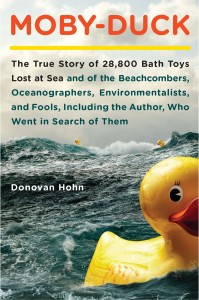I like literary surprises. And if there’s a recent book that surprised me it is Moby Duck: The True Story of 28,800 Bath Toys Lost at Sea and of the Beachcombers, Oceanographers, Environmentalists, and Fools, Including the Author, Who Went in Search of Them by Donovan Hohn. Here’s a non-fiction book that reads like an epic literary tale. And its subject matter seems anything but epic. This is the story of 28,800 bathtub toys (blue turtles, green frogs, redbeavers, and yellow ducks) on their way from China to the US inside a shipping container. That container falls overboard during a storm and breaks open. Soon, all those bathtub toys have been release into the ocean and begin their amazing journeys.
The author takes up this fascinating tale and begins his own journey which leads to unexpected surprises. He meets professional beach combers who’ve found the rubber toys all along the west coast of the United States, many of which have landed on remote beaches in Alaska. He treks to China to visit the plant where the toys were made. He heads to Hawaii to learn more about the realities of plastics that have made it into the oceans. He even boards an Ice breaker to travel through the worlds northernmost oceans to see how far the ducks may have travelled. All of this he views through a lens that asks questions about humanity and the environment without ever coming across as preachy or political.
When Hohn started this project, he was a high school English teacher, the kind of teacher we could use more of right now. This book was actually inspired by a student essay. It’s obvious that Hohn loves great literature. While much non-fiction is interesting to read, it’s usually the story that engages, not the beautiful writing. But in Moby Duck, I found myself re-reading passages simply for the delight of the writing. Take this example:
Let's draw a bath. Let's set a rubber duck afloat. Look at it wobbling there. What misanthrope, what damp, drizzly November of sourpuss, upon beholding a rubber duck afloat, does not feel a Crayola ray of sunshine brightening his gloomy heart?
And then there are the fantastic bits of information. Consider these colorful factoids about the relationship of toys to plastics:
Annual toy sales in America shot from $84 million in 1940 to $1.25 billion in 1960. Peg-and-socket pop beads sold to girls as costume jewelry consumed forty thousand pounds of polyethylene resin per month in 1956. In 1958, hula hoops and Frisbees consumed fifteen million pounds of the stuff. Polystyrene replaced balsa wood as the most popular material for model cars and planes. Plasticized polyvinyl chloride, the material from which the brand-new Barbie doll was made, provided a cheaper, more durable alternative to latex rubber, rendering traditional molded rubber animals and dolls obsolete except in name.
That's just one of the sections of the book that will make you reconsider the amount of plastic we use. Particularly since much of it seems to be floating aimlessly in the planet's oceans and occasionally washing ashore to sully our beaches.
Moby Duck was almost the first book ever to get five Jeffies. But in the end I had to lower my rating to four. Not because the book isn’t brilliant, but because the ending is less than satisfying. It’s no fault of the author, it’s just that the story didn’t end the way it needed to in order to get that elusive fifth Jeffy. Hohn couldn’t have known that when he set out on his journey to tell this story, the ending wouldn’t be as brilliant as the book. Even without the perfect ending, this is a book well worth reading.



Oh that elusive fifth Jeffie. He is so coy. This book does sound fascinating. Who knew a rubber ducky could be so entertaining.
ReplyDelete